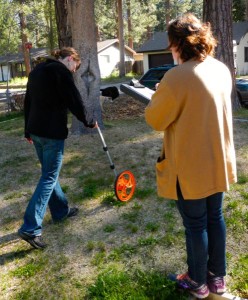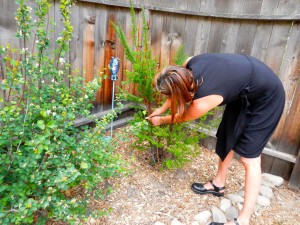Turf buyback sprouts endless possibilities
Publisher’s note: This is one in a random series of stories about what it’s like to go through the South Tahoe Public Utility District turf buyback program.
By Kathryn Reed
I’m exhausted and overwhelmed, and I haven’t turned over one blade of grass. It’s going to be a long summer, or two.
My front yard – the only place where there is grass – has never been much to look at. It became less functional years ago when a tree removal company parked a crane on it. It made croquet balls hop instead of roll. Then there was the summer I spread fertilizer, but didn’t water it immediately.
Why would I want to keep watering a lawn I didn’t like?
And with South Tahoe Public Utility District installing a water meter last summer, how much I pay to water that grass is about to change. Something had to be done.
I got myself on the waiting list for the turf buyback program last year and this year I am part of the program.

Donielle Morse, left, and Lannette Rangel with South Tahoe PUD take turf measurements. Photos/Kathryn Reed
Last week Donielle Morse and Lannette Rangel with STPUD came out to measure the turf – 804-square-feet; and have me sign a contract – I must keep the new stuff in for five years, plant native or low water consuming plants over 35 percent of the area, and use a better, low water use irrigation system. They told me other particulars to ensure I will qualify for the $1,206 rebate check.
The buyback program is open to all South Tahoe PUD water customers. The most anyone will get is $3,000. The equation is $1.50 per square foot.
They took pictures and will do the same when I call for the final inspection.
I’m supposed to keep a list of all the plants I use, create a sketch of where things go and have stats about the irrigation system. (Hand watering is also an option.) I have a sprinkler system so it seems logical to convert it.
I ask about transplanting things from the back to the front. That’s OK, but they suggest I ask the TRCD about how well specific vegetation does when moved.
That afternoon Jennifer Cressy with the Tahoe Resource Conservation District came out. The free consultation is part of the program. She gives me ideas about how to relocate some of the established plants I have and says others aren’t transplantable.
“Talk nice to it the whole time,” she says of the bushes I’m eyeing to move. She also says to make sure my shovel is sharpened. (I didn’t bother to tell her I’ve never thought about sharpening a shovel before.)
She peruses the other things growing in the back and points out how the roses would be easy to transplant. Hmmm. I hadn’t thought about that and suddenly see potential.
I already knew all sides of the house were going to be disturbed in this remake. It might get messier and more complicated, though, than I anticipated. It’s a good thing I have two seasons to get the turf out and have the area revegetated.

Jennifer Cressy with Tahoe Resource Conservation District shows where to thin a bush before replanting it.
“One of the easier techniques is composting the lawn in place if you are doing it yourself,” Cressy tells me.
Cressy introduced me to the term sheet mulching. I have since read more about it. It seems like an easier alternative than what I thought I was going to have to do, which was haul away all of my grass. Some of the literature even says I won’t have to take all the grass out, but instead I could kill it by blocking out the sun.
With a sod cutter I’d need to be wary of tree roots.
Cressy offers simple tips – like when ordering soil amendment, get extra for future projects; have any deliveries be dumped onto a tarp so it’s easier to scoop it up at the end; plant shallow rooted vegetation near trees because the trees absorb so much water; pay attention to where snow is shoveled or dumped by the city so flexible bushes go there.
When it comes to what to plant that is determined on a site-by-site case. I’m on an extremely high water table so that will make a difference in what I can plant compared to someone who is on a slope.
“Climate and native appropriate plants” are what we all should be shopping for.
Cressy throws out the idea of a raised vegetable bed near the door. She adds that edibles and plants that smell good should be near the walkways.
I’m on information overload. But she gets me thinking. Next step – put a design onto paper.
—–
Notes:
· Tahoe Resource Conservation District has a wealth of landscaping information online – not just for those taking out turf.
· More information about South Tahoe PUD’s turf buyback program is online. The website also has information about the current water restrictions.
· The Evans’ Family Garden in the Angora burn area has examples of appropriate vegetation for the Lake Tahoe Basin.
· Here is a list of landscaping workshops for the do-it-yourself gardeners, landscapers and landscape managers.